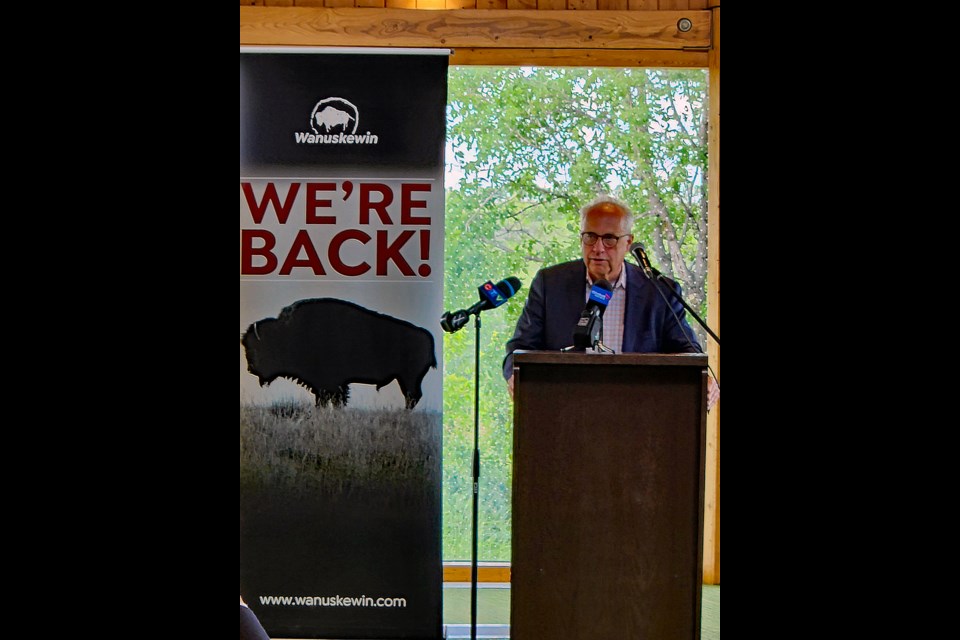WANUSKEWIN — Wanuskewin Heritage Park celebrated its 30th anniversary on Monday, June 27, in a simple ceremony that coincided with the unveiling of a new exhibit chronicling the journey of the cultural facility that, today, tells the stories of the peoples who inhabited the land for thousands of years.
Dr. Ernie Walker, the park’s chief archaeologist and a professor at the University of Saskatchewan’s Department of Archaeology and Anthropology, was among those invited to speak to everyone gathered near the grand hallway of the visitor centre. He is one of the founders of the park.
Former Meewasin Valley Authority president and chief executive officer Susan Lamb, who is also one of the park’s founders, current WHP CEO Darlene Brander and WHP board of directors chair Candace Wasacase Lafferty were the other speakers.
“I always try to say to everyone that this is not the Ernie Walker story. As I have told everyone connected with this project, it is 40 years. Wanuskewin had opened 30 years ago but I count the 10 years before that when the project started.,” Walker told SASKTODAY with a smile.
“I said in my remarks, Wanuskewin is an improbable success story because of the way it was built; the community did it, and it is not a government facility,” he said of the park, which is trying to earn a spot on the UNESCO World Heritage Site list.
Walker said that although the park officially opened in 1992, planning to protect the site started way back in 1980 after historical artifacts including a medicine wheel were uncovered in the cattle ranch owned by his friend Michael Vitkowski.
“He [Vitkowski] was reclusive and a bit of a curmudgeon but he was a good friend of mine. I worked on his ranch before and that is where it all started. The late Senator Hilliard McNab was mentioned as the first elder who got involved with this project,” said Walker.
“The former senator was also a good friend of mine. He was a [postdoctoral] fellow at that time and I was just a young faculty member [at USask] at that time, but we bonded and became friends. That started all of this. I wish they [Vitkowski and McNab] were here to see this.”
He added that he also thanked the very first group of elders who took the chance on the project along with the thousands of members of the community who got involved as the years went by until Wanuskewin finally opened 30 years ago.
Walker said it was a long and hard road to make Wanuskewin the cultural and historical site that is today, a facility about 10 minutes away from the city.
"There have been good days and there have been bad. Overall, we’ve heard several people say it’s kind of a beacon for the rest of the country that what we do here is important. First Nations culture and history are here, both past and present,” said Walker.
“Our fabulous bison herd is returning to what is now agricultural fields, back to their natural grasslands and environment, and the art gallery. It is just the robustness of it all. It is like going back in time. So, I’m very happy about all of this. There were days when we thought that this would not happen. But now, we are here.”
He added that they are now busy with Wanuskewin’s bid to be included on the UNESCO World Heritage Site list, but he believes there are still exciting things that they have not yet uncovered.
“We’re really busy so we’re not doing a lot of excavations. There is a lab here and the artifacts are there and we also do research. Those are among the other things that we do. But there is just something special about Wanuskewin,” he said.
“Make no mistake, Wanuskewin wants and needs to become a World Heritage site. We’re here to reflect on our accomplishments, but the story is not yet complete. Our appetite is not satiated. There’s more to come. The Great Spirit is not finished with us yet.”




